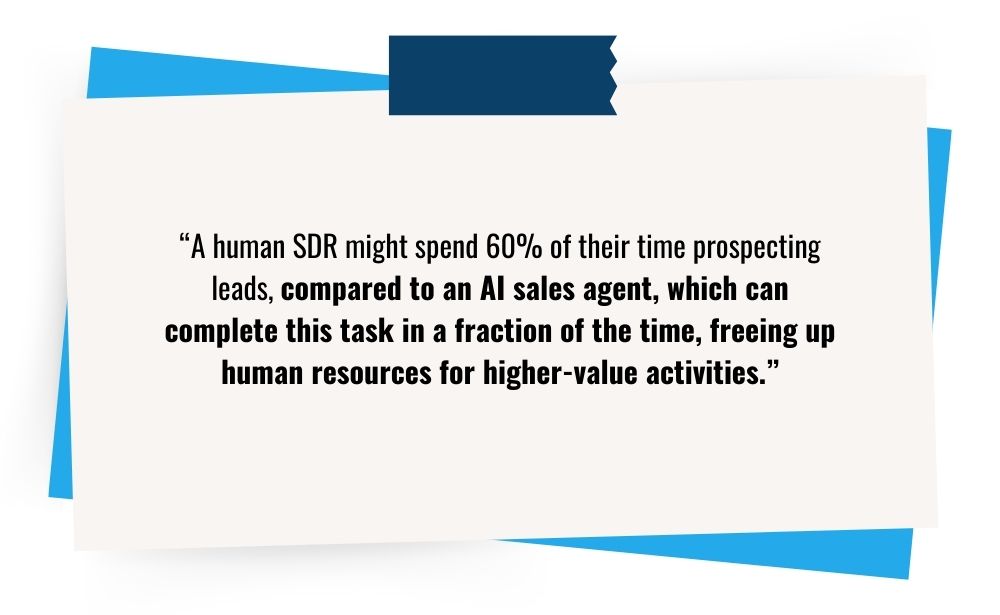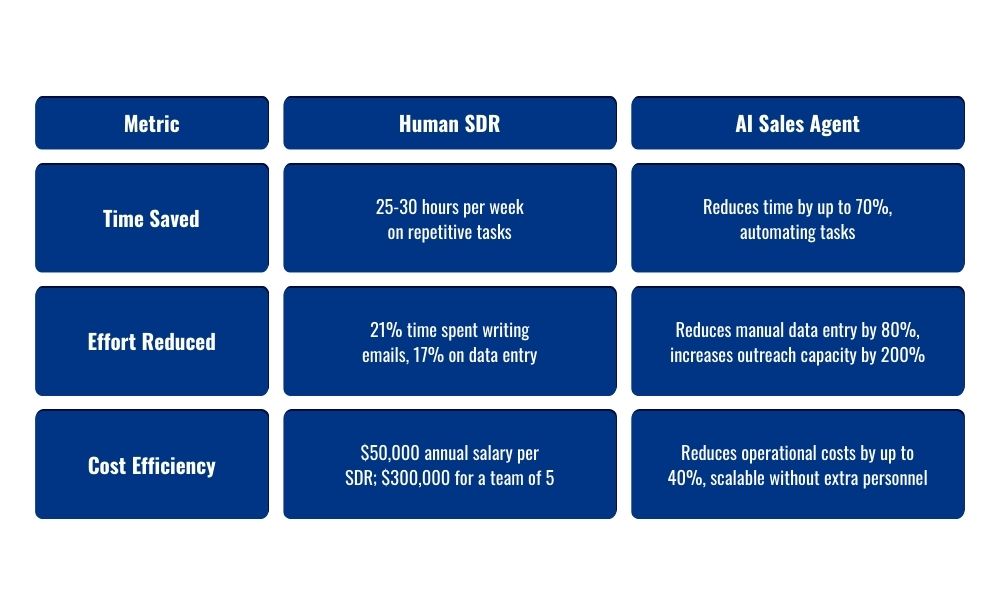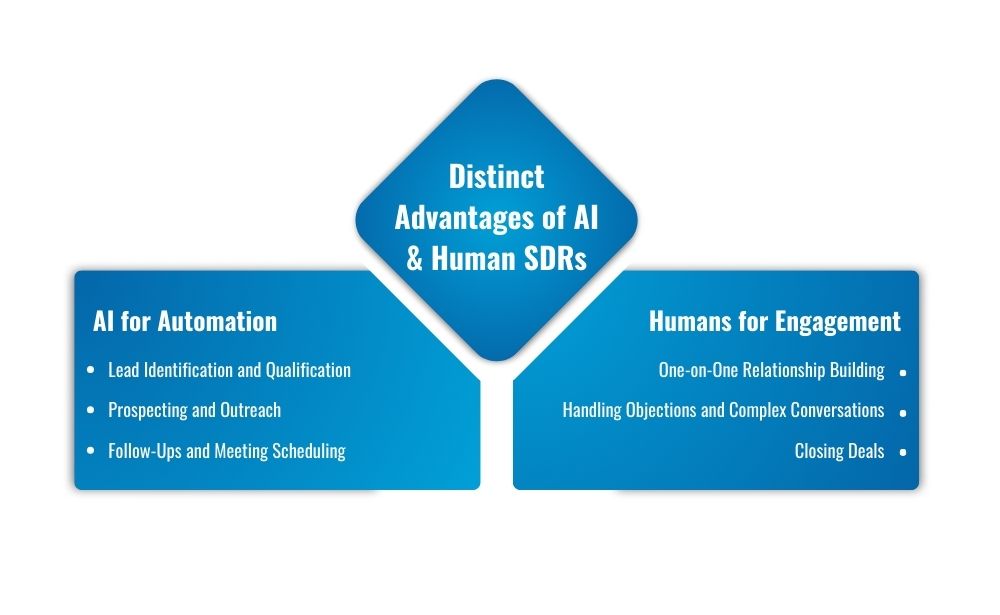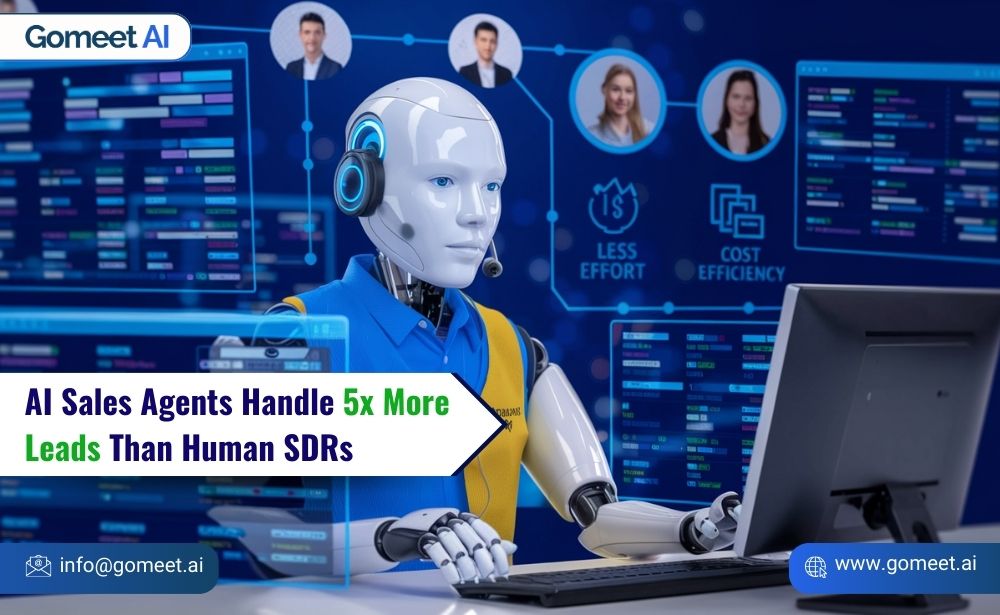The B2B sales landscape is evolving faster than ever, driven by the integration of advanced technologies like artificial intelligence (AI). While human sales development representatives (SDRs) have long been the backbone of lead generation and client outreach, the rise of AI sales agents is shifting the way businesses manage repetitive sales tasks. The question is no longer about whether AI can replace humans but rather how it can complement human efforts to enhance efficiency and results.
In this blog, we’ll explore the key differences between AI sales assistants and human SDRs, particularly in handling repetitive tasks, and offer insights into how businesses can leverage both to achieve optimum performance.
The Role of Human SDRs and AI Sales Agents in Sales Operations
Human SDRs have traditionally been responsible for a wide range of sales activities, from lead qualification and cold outreach to follow-ups and meeting scheduling. These tasks, while crucial, often require a significant amount of time and manual effort, particularly in high-volume sales environments.
On the other hand, AI agents are specifically designed to automate these repetitive tasks. AI sales assistants are programmed to handle activities such as identifying potential leads, sending personalized outreach emails, following up with prospects, and even scheduling meetings. With AI sales tools’ ability to analyze large data sets and engage multiple leads simultaneously, businesses are now equipped with a tool that can streamline these tasks at scale.
This leads us to an important comparison: how do human SDRs and AI sales agents differ in handling these essential sales tasks?
Human SDRs vs. AI Agents: Handling Repetitive Sales Tasks
Human SDRs and the Effort of Manual Work
Human SDRs are adept at performing outreach and follow-ups, but these tasks come with limitations. A human SDR can only engage with so many leads at a time, often spending hours researching, qualifying, and crafting personalized messages. Moreover, the volume of leads a human SDR can manage is constrained by the workday, leading to missed opportunities when follow-ups are delayed or forgotten.
AI Sales Agents and the Power of Automation
AI sales agents, by contrast, can handle these same tasks with minimal human intervention. With AI-driven tools, tasks like prospect identification, email follow-ups, and meeting scheduling are executed with greater efficiency and consistency. AI agents can engage hundreds of leads simultaneously, ensuring no prospect is overlooked, and all follow-ups are timely and automated based on pre-set triggers.

Statistical Comparison: Time, Effort, and Cost
Let’s break down the differences in time, effort, and cost when using human SDRs vs. AI sales assistants:
Time Saved
- On average, a human SDR spends 25-30 hours per week on repetitive tasks like prospecting, outreach, and follow-ups. This includes time spent crafting emails, scheduling meetings, and monitoring responses.
- AI sales assistants reduce this time by up to 70%, automating outreach and follow-ups in real-time. AI can handle in seconds what a human SDR would take hours to complete.
Effort Reduced
- According to industry studies, sales reps spend approximately 21% of their time writing emails and another 17% on data entry and research. This can result in significant burnout, particularly in high-volume environments where these tasks are repetitive and time-consuming.
- In contrast, AI-powered sales assistant software handles these tasks automatically, without tiring or making errors. For instance, AI tools can reduce manual data entry by 80% and increase outreach capacity by 200%.
Cost Efficiency
- The average annual salary for a sales development representative in the U.S. is around $50,000, which doesn’t include benefits, training, or the cost of tools and technology. Managing a team of 5 SDRs can cost upwards of $300,000 annually, not including the overhead costs.
- However, AI sales tools can reduce operational costs by up to 40% while handling tasks equivalent to a team of human SDRs. Furthermore, AI is scalable, meaning businesses can expand their outreach efforts without needing additional personnel.

Intelligence Levels: AI vs. Human SDRs
AI sales agents excel at managing large volumes of data and executing routine tasks with precision. Their intelligence lies in their ability to learn from data, identify patterns, and automate processes that would otherwise take up a significant portion of a human SDR’s time.
For example, AI can quickly analyze a prospect’s engagement history, determine the best time to send follow-up emails, and schedule meetings based on mutual availability—all without requiring human input.
While AI sales tools are powerful for automation, they lack the emotional intelligence and creativity that human SDRs bring to the table. Human SDRs excel in building meaningful, one-on-one relationships with prospects. They can handle objections, navigate complex negotiations, and create personalized strategies to close deals. Emotional cues, empathy, and the ability to adapt to evolving conversations are areas where human intelligence still outshines AI.
Where Each Shines: AI for Automation, Humans for Engagement
AI Sales Agents for Repetitive Tasks
AI is best suited for managing high-volume, repetitive tasks such as:
- Lead Identification and Qualification: AI agents can automatically sift through databases to find and prioritize potential leads based on predefined criteria.
- Prospecting and Outreach: AI can send personalized, timely outreach emails to hundreds of prospects simultaneously, optimizing response rates.
- Follow-Ups and Meeting Scheduling: AI ensures that no follow-up is missed and meetings are scheduled efficiently, reducing delays and increasing prospect engagement.
Human SDRs for Relationship Building and Deal Closing
Human SDRs, on the other hand, are indispensable when it comes to:
- One-on-One Relationship Building: Human SDRs can connect with prospects on a deeper level, understanding their unique pain points and offering tailored solutions.
- Handling Objections and Complex Conversations: Human intelligence excels in dynamic conversations, where quick thinking and empathy are essential.
- Closing Deals: High-value deals often require the personal touch of a human SDR who can negotiate terms, answer questions, and build trust.

The Hybrid Approach: Combining AI and Human SDRs
By leveraging both AI sales agents and human SDRs, businesses can create a hybrid sales model that maximizes productivity and performance. AI can take care of the repetitive, time-consuming tasks that often bog down human SDRs, freeing them to focus on the critical stages of relationship-building and deal closing. This collaboration between human intelligence and AI automation creates a more efficient, scalable, and results-driven sales process.
Conclusion
As the B2B sales sector continues to evolve, the synergy between AI sales agents and human SDRs is becoming increasingly clear. AI sales assistants excel at managing and automating repetitive tasks, while human SDRs bring the emotional intelligence and problem-solving skills needed to close deals and build lasting relationships.
Platforms like GoMeet AI offer AI-powered sales assistant software that helps B2B businesses automate these repetitive tasks, enabling human sales teams to focus on building relationships and closing deals.

